Moist, airy, and light, Japanese Strawberry Shortcake is among the most popular cakes in Japan. This elegant and classic dessert is perfect for any celebration. Here, I share how to keep the sponge cake moist and decorate it with berries and fresh whipped cream.

Strawberry Shortcake is probably one of the most popular and classic cakes in Japan. Whether it’s for birthdays, Christmas (did you know this cake is also sold as “Christmas Cake”?) or any type of celebration, we enjoy Strawberry Shortcake all year round. Cakes have such a special place in Japanese culture that we even bring them when we visit friends and family.
If you need a classy dessert to serve at your dinner party or something special for a bridal shower, a beautiful homemade Japanese Strawberry Cake fits the bill for the most special occasions. With some basics from the pantry, this simple yet elegant cake is one to remember when celebration season hits. Or when the strawberry is in season in your area, you have good enough reason to whip up this sweet treat to celebrate. I promise, your guests will fall hard for it!
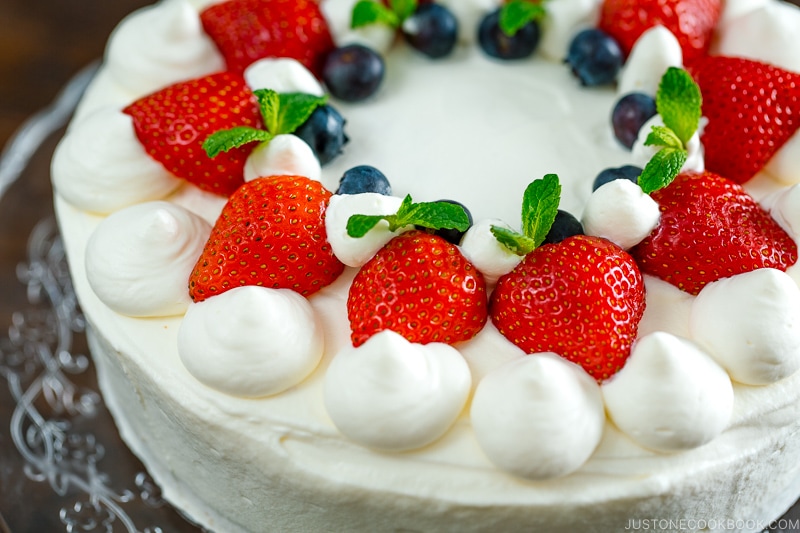
What is the Japanese Strawberry Shortcake?
The concept of the Japanese Strawberry Shortcake may have originated in the US with some adaptation. Instead of sweet biscuits, a Japanese strawberry shortcake is made of 2-3 layers of sponge cake, with fresh strawberry slices, whipped cream filling, and whipped cream frosting.
This cake might seem rather simple, yet when all the components are prepared perfectly, it comes together as an amazing dessert.
The majority of recipes for Japanese strawberry shortcakes are very similar, so what makes them different? It all comes down to the various techniques you use when making it. I want to thank my dear friend Naomi for spending hours in my kitchen testing different variations of strawberry shortcake recipes with me. We spent days testing and making so many cakes, and we decided this is by far the best one.
Because this recipe requires detailed explanations, it was impossible for Mr. JOC to take step-by-step pictures AND film the video at the same time. Therefore, we decided to focus on the step-by-step pictures this time because I can’t explain everything in our short video. We’ll add a video for this recipe in the future.
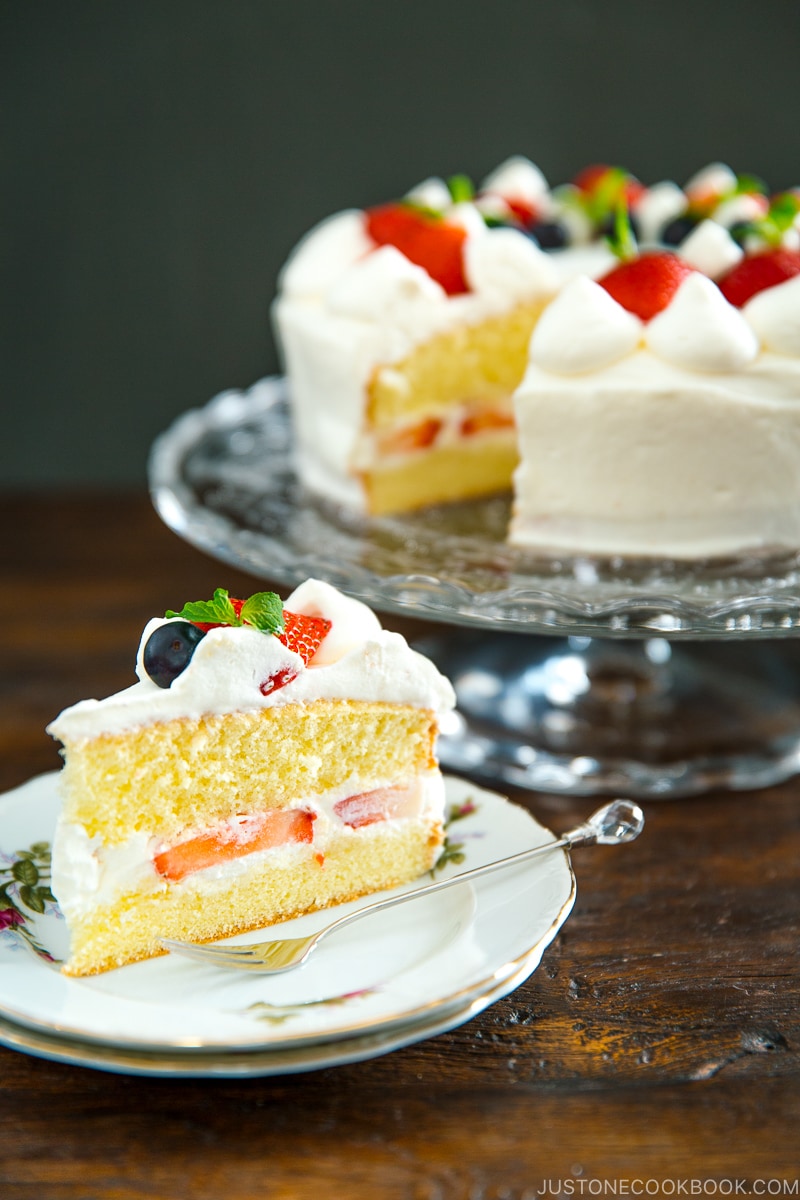
Components of Japanese Strawberry Shortcake
This recipe is probably one of the longest recipes on my blog, with close to 50 steps. I know it’s a bit of an overkill but I really think these step-by-step pictures are helpful and I can explain the step a little more in detail along the way.
Japanese strawberry shortcake consists of 3 components: sponge cake, whipped cream, and strawberries. It’s simple as that. However, creating the perfect sponge cake and whipped cream involves many techniques.
And to make a really good shortcake, precise measurement (please use a kitchen scale and thermometer!) really helps, especially if you don’t bake often.
Sponge Cake
Japanese sponge cake is very moist, airy, light, and it’s not overly sweet. Personally, I think this is the most important part of the cake.
The sponge cake is a genoise cake. It‘s made by beating air into the eggs to make it rise. This replaces a chemical leavening agent like baking soda or baking powder.
The dimensions of the sponge cake we need to consider include sweetness, elasticity, and texture.
The sponge cake cannot be too sweet or else it overpowers the whipped cream and the tartness of the strawberry. The sweetness has to be perfectly balanced with the rest of the cake.
When you bite into the sponge cake, it needs to have some elasticity and firmness of bite. Once again, if it’s too hard or too soft, it ruins the cake.
Lastly and probably the most critical is the texture of the sponge cake. The size of the bubbles within the sponge needs to be consistent. It should not be too rough on the tongue yet it does need some structure so you can feel them. This is probably the part I tested the most to achieve the perfect result.
By the way, if you want to bake a flat cake (my cake is a little curve on the top), I found a great article to solve this problem!
Freshly Whipped Cream
To make fresh whipped cream is not too difficult. Before you begin whipping cream, make sure to chill your bowl and the heavy cream. This allows the cream to stay cold longer during the whipping process. Basically, cream whips better when it’s cold. The temperature affects how long it requires to whip, how light and fluffy it will get, and how long it is likely to stay that way (more science here).
My friend and I have tested the different amounts of sugar and we concluded that 8% of sugar to heavy whipping cream ratio gives perfect sweetness for the cake.
Fresh Strawberries
Fresh strawberries might not be the easiest ingredient to purchase depends on where you live. I know I’m spoiled in California where we literally have strawberries all year round. When you select the strawberries, make sure they are equal in size and not too large so they’ll be more visually appealing.
Last note, since we do not wash the strawberries but clean them with a damp cloth (to prevent them from going bad and adding moisture to the cream.), I do recommend buying organic ones.
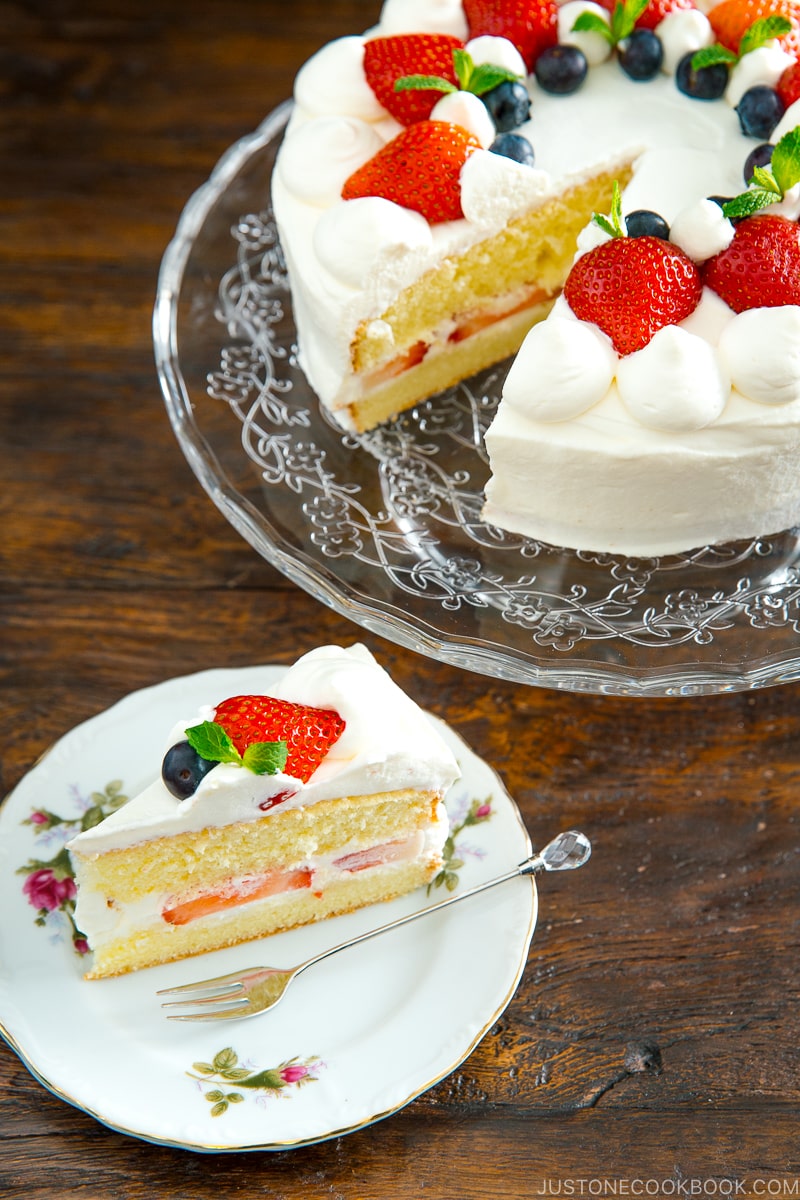
Japanese Strawberry Shortcake for the Holidays
After several recipe testings, I am really happy with my results. My friends and family who enjoyed the cake agreed as well. Since then, I’ve served the Japanese strawberry shortcake several times over the holidays and it’s been a huge hit.
The flavor and texture of strawberry shortcake get even better if you let it rest overnight, so it is also a great make-ahead treat.
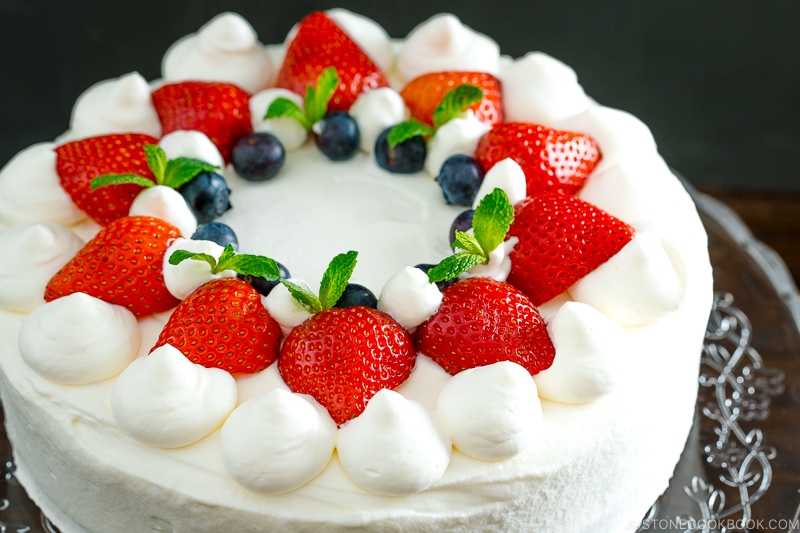
Wish to learn more about Japanese cooking? Sign up for our free newsletter to receive cooking tips & recipe updates! And stay in touch with me on Facebook, Pinterest, YouTube, and Instagram.
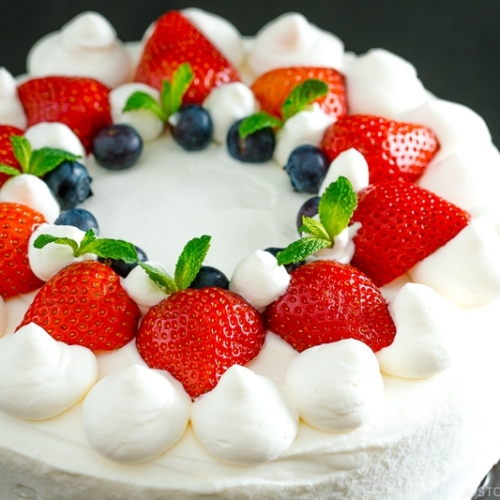
Japanese Strawberry Shortcake
Ingredients
- 1 Tbsp butter (for greasing the pan; or use shortening or cooking spray)
For the Sponge Cake
- 3 Tbsp unsalted butter
- 2 Tbsp whole milk (use whole milk for the best results)
- 4 large eggs (50 g each w/o shell)
- ½ cup sugar (½ cup + 2 Tbsp, to be precise)
- 1 cup cake flour (weigh your flour or use the “fluff and sprinkle“ method and level it off; see Notes for how to make your own cake flour)
For the Syrup
- 2 Tbsp water
- 3 Tbsp sugar
- 1 Tbsp liquor of your choice (optional; I like orange liqueurs like Grand Marnier or Cointreau)
For the Fresh Whipped Cream
- 2 cups heavy (whipping) cream (36% fat; must be at least 30–35% fat)
- 3 Tbsp sugar
For the Decoration
- 1 lb strawberries (for filling and decoration; look for similar-sized strawberries to decorate the cake; buy an extra pack to increase your chances of finding berries of the same size)
- 10 blueberries
- 2 sprigs mint leaves
Instructions
Before You Start…
- Gather all the ingredients. I highly encourage you to weigh your ingredients using a kitchen scale for this recipe. Click on the “Metric“ button at the top of the recipe to convert the ingredient measurements to metric. If you‘re using a cup measurement, please follow the “fluff and sprinkle“ method: Fluff your flour with a spoon, sprinkle the flour into your measuring cup, and level it off. Otherwise, you may scoop more flour than you need.

- Make sure the eggs and butter are at room temperature. Sift the cake flour at least twice.

To Prepare the Pan, Oven, and Double Boiler
- Place an 8-inch (20-cm) cake pan on top of parchment paper, trace around the pan, and cut out 1 circle. Grease one side of the parchment paper and both the bottom and sides of 1 cake pan with 1 Tbsp butter. Then fit the parchment paper in the cake pan, greased side up. I avoid parchment paper on the sides because sometimes it pulls the batter and affects the final result of the cake.

- Preheat your oven to 350ºF (180ºC). For a convection oven, reduce cooking temperature by 25ºF (15ºC). It’s always better to preheat longer, preferably 15–20 minutes extra. Tip: You preheat the oven so that all the surfaces inside your oven (walls, floor, door, and racks) are the desired cooking temperature. This makes for an even temperature throughout the oven and you won’t lose as much heat when you open the door for a few seconds. Depending on your oven, preheating might take 10 to 20 minutes.

- Prepare a double boiler. If you have never done this before, please see the Notes section below. Turn on the stove’s heat to high and bring the water in the saucepan (Pot A) to a rapid boil. Once boiling, reduce the heat to maintain a steady simmer. Put 3 Tbsp unsalted butter in the small bowl (Bowl #1) and set over the saucepan. Let the butter melt gently.

- Once the butter is melted, remove the bowl from the saucepan. Then add 2 Tbsp whole milk and whisk to combine. Set aside to keep it around 104ºF (40ºC). Tip: I highly recommend using whole milk instead of reduced-fat milk. I’ve tried using both and concluded that whole-fat milk makes a difference in the final result.

To Make the Sponge Cake (can make a day ahead)
- In a stand mixer bowl (Bowl #2), add 4 large eggs (50 g each w/o shell) and break the egg yolks and whites with your whisk.

- Add ½ cup sugar (½ cup + 2 Tbsp, to be precise) and whisk to combine.

- In a large pot (Pot B), bring about 2 inches of water to 140ºF (60ºC) and maintain the temperature. Then, set the stand mixer bowl (Bowl #2) directly over the pot and whisk constantly so the eggs don’t scramble. This is called a bain-marie or water bath, where you set the bowl of food directly over a larger container of simmering water to temper the heat for gentle, even cooking. You can also use the double boiler method, where you set the egg mixture bowl (Bowl #2) over Pot B. The bowl doesn’t touch the simmering water of the pot.

- Whisk until the temperature of the egg mixture reaches 104ºF (40ºC). Remove Bowl #2 from Pot B and set it up on the stand mixer with the whisk attachment.

- Whisk on high speed (Speed 10) until the mixture is fluffy, for about 2 minutes. The batter should be loose yet thick and glossy.

- When the batter is pale, fluffy, and tripled in volume, reduce the speed to low (Speed 4) for several seconds. Stop the mixer and lift some of the batter with the whisk to check the consistency. If the batter falls off your whisk in a solid line or ribbon on top of the mixture, you’ve reached the “ribbon stage” (see Notes). Remove the bowl from the stand mixer.

- Add half of the 1 cup cake flour to the bowl. Using the whisk, fold gently but thoroughly. Do this by rotating your bowl slowly while simultaneously moving your whisk in a down-and-over motion.

- Add the rest of the flour and fold gently to make sure all the flour is incorporated quickly so your mixture doesn’t deflate.

- With your spatula, take out one scoop of the batter from the bowl and add it to the butter and milk mixture. Tip: If we add the butter and milk mixture into the entire cake batter, the fat in the butter will deflate the batter.

- Incorporate the butter and milk mixture into a small amount of the batter first before adding it to the entire cake batter.

- Add the mixture back into the cake batter by pouring it over a silicone spatula. This prevents the mixture from deflating the batter and helps disperse the mixture. Gently fold until incorporated. When you lift the spatula, the batter should fall like a ribbon.

- Pour the batter into the center of the cake pan, from right above the cake pan. You want to avoid introducing extra air into the batter at this point. Collect the leftover batter in the bowl and pour it around the edges of the cake pan, not the center.

- Firmly tap the cake pan on the counter to release air bubbles in the batter.

To Bake
- In the preheated oven, bake at 350ºF (180ºC) for 20–25 minutes. Check if the sponge cake is done by inserting a skewer in the middle; if it comes out clean, the cake is ready. While the cake is baking, start preparations for the cake assembly (see below).

- As soon as you take out the cake pan from the oven, drop it on the counter to “shock” the cake so it stops shrinking. Separate the cake from the pan by running a sharp knife or offset spatula around the sides.

- Take the cake out of the pan by placing the wire rack on top and flipping the cake over onto the rack.

- Immediately remove the parchment paper.

- Place another wire rack on top and flip it back over. The top of the cake is now facing up.

- Cover the cake with a damp towel until cooled to keep moisture in the cake. Make sure the towel is thin (not heavy) and wring the water out well so that the towel is damp, not wet. I use IKEA’s thin dish towel. If you keep the sponge cake for later use, wrap it with plastic wrap after it‘s completely cooled and keep it in the fridge (see Notes). Tip: You can make the sponge cake the day before. It actually tastes better and it's easier to slice the cake in half.

To Prepare the Strawberries and Syrup (While the Cake is Baking)
- While the cake is baking, divide 1 lb strawberries into 2 groups, one for the decoration and the other for the filling. Keep the beautiful, same-sized strawberries for the decoration. Remove the husk and clean the strawberries with a damp paper towel (do not wash, as we don’t want the strawberries to be moist and become moldy). Slice off the core for all the strawberries.

- For the strawberries that we will use for the decoration, cut them in half lengthwise. For the strawberries that we will use for filling, slice them lengthwise into ¼-inch (5 mm) slices.

- To make the syrup, combine 2 Tbsp water, 3 Tbsp sugar, and 1 Tbsp liquor of your choice (optional) in a small bowl (Bowl #3). Microwave for 1 minute to dissolve the sugar.

To Make the Fresh Whipped Cream (While the Cake is Cooling)
- While the cake is cooling, prepare an ice bath by placing ice cubes and water in a large bowl (Bowl #4). Place a clean and dry mixing bowl (Bowl #2) in the ice bath and add 2 cups heavy (whipping) cream and 3 Tbsp sugar to keep it cold. Tip: For the perfect sweetness, the sugar should be 8% of the heavy cream weight.

- Transfer the mixing bowl to the stand mixer and whisk on high speed. The cream will become thicker and smooth. When you lift the whisk out of the cream while it’s still liquid, and the cream holds its shape as it drops, it’s ready. Remove the bowl from the stand mixer and put it back in the ice bath.

To Assemble the Cake
- With a serrated knife, slice the cooled cake horizontally into half to make 2 layers (top and bottom).

- Place the bottom of the cake on the cake circle. Brush the syrup on the top and sides of the bottom layer. This will help the sponge cake stay moist.

- Using a hand whisk, whisk only the cream at one spot by the edge of the bowl instead of whisking the entire bowl of cream. We will make the whipped cream as we need it. With this approach, we can also control the stiffness of the whipped cream.

- When the cream at the edge of the bowl reaches medium peaks, transfer it to the top of the bottom cake layer. Medium peaks mean when you lift the whisk, the cream will hold its shape, but the tip of the peaks will fold back on itself.

- Spread the whipped cream evenly. If you don’t have enough whipped cream, whip more and add it onto the cake.

- Place the sliced strawberries on top of the whipped cream as you see in the pictures. Keep the center area open by not covering it with strawberries. This will make it easier to cut the cake into slices.

- Whip the cream again at the edge of the bowl.

- Transfer the whipped cream to the top of the strawberry layer. Spread just enough cream to cover the strawberries; do not add too much.

- Place the top layer of the sponge cake over the bottom layer. Brush the syrup on the top and sides of the sponge cake.

- Whip more cream and place it on top of the cake.

- Place the tip of the offset spatula in the center of the cake at a 30-degree angle and turn the cake turntable toward you to create a smooth top. Lightly coat the sides of the cake with a thin layer of whipped cream.

- Now add more cream to the sides, little by little. Place the offset spatula at a 90-degree angle and push the turntable away from you.

- Remove the excess cream from the cake and put it back into the bowl.

To Decorate the Cake
- For a basic decoration, I use a Wilton 2A decorating tip. Put the tip in the piping bag and cut off the tip so the metal will show from the bag. Fold the top half of the bag outward as you see in the picture (over your hands).

- Whip the cream to stiff peaks. When you lift the whisk, the peaks will hold firm. Put the cream into the piping bag. Once you fill the bag halfway, lift up the top half of the bag and push the cream down toward the tip.

- Squeeze the piping bag to test to make sure the cream comes out smoothly. When you’re ready, hold the piping bag at a 90-degree angle and squeeze about a 1-inch-wide ring of whipped cream around the top edge of the cake. This will be the base for the strawberries.

- Decorate and place the strawberries cut-side down on top of the whipped cream. Then squeeze small dollops of whipped cream between and around all the strawberries. Place 10 blueberries between the whipped cream dollops. Place 2 sprigs mint leaves as desired to add color.

To Store
- I recommend putting the cake on a cake stand with a dome or in a cake box to keep the cake shape while preventing it from drying. Keep the cake in the refrigerator and enjoy it within 2 days.
Notes
- For 1 cup cake flour, measure 1 cup all-purpose flour, then take away 2 Tbsp all-purpose flour and add 2 Tbsp cornstarch. Be sure to sift the flour to distribute the cornstarch well before using it in your cake batter.
- small heat-resistant bowl (Bowl #1)
- small saucepan that fits Bowl #1 for the double boiler (Pot A)
- stand mixer bowl or large mixing bowl (Bowl #2)
- large pot that fits Bowl #2 for the bain-marie (Pot B)
- small bowl (Bowl #3)
- large bowl that fits Bowl #2 for the ice bath (Bowl #4)
- parchment paper
- cake pan (8 inches/20 cm)
- balloon whisk
- silicone spatula
- 2 wire racks
- offset spatula
- cake decorating tip Wilton 2A and plastic bag
- thermometer
- serrated knife
- cake circle (10″/25 cm)
- cake turntable
- cake stand with dome or cake box
Nutrition
Editor’s Note: The post was originally published on December 14, 2015
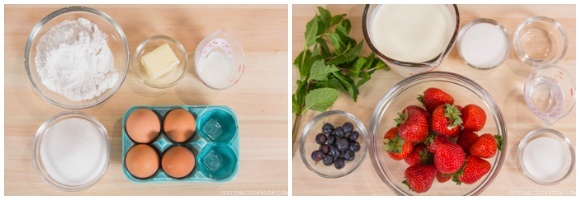
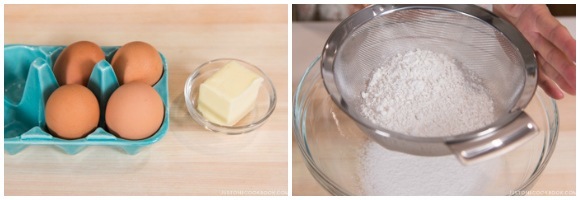
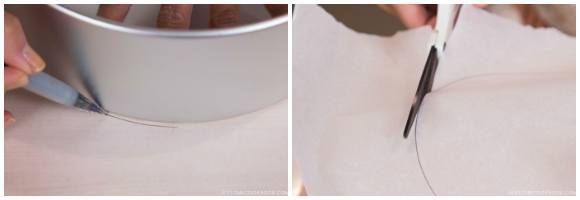
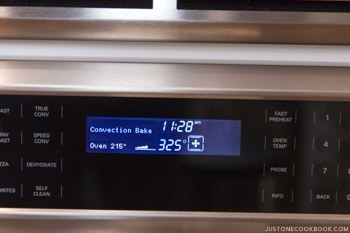
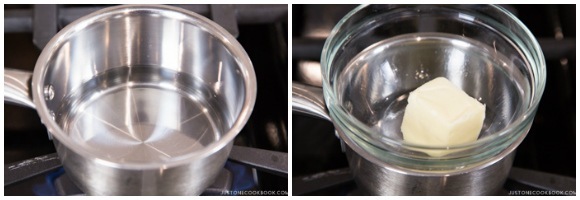
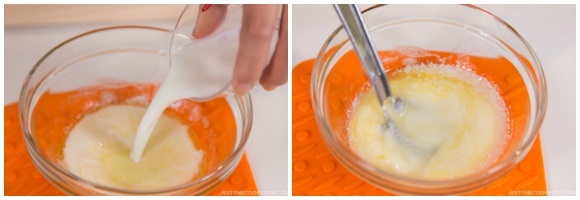

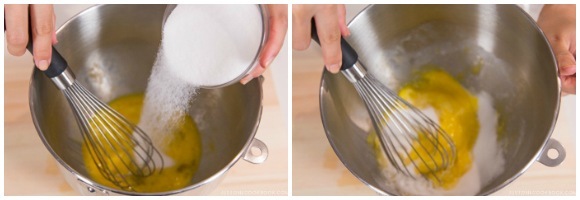
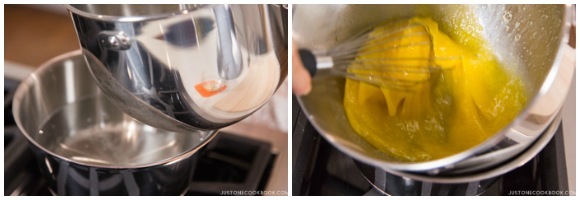

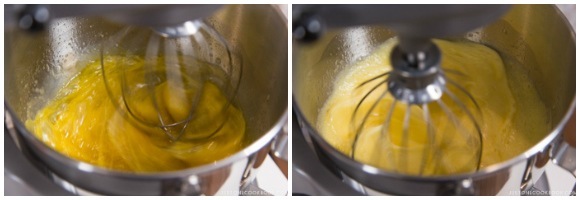
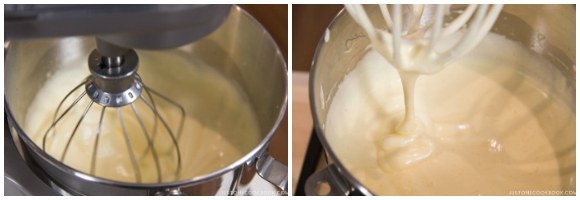
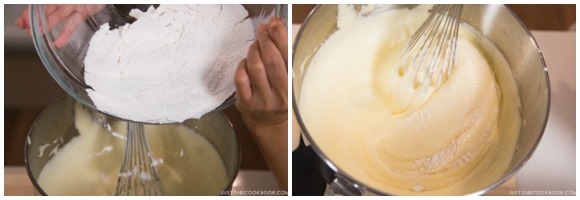
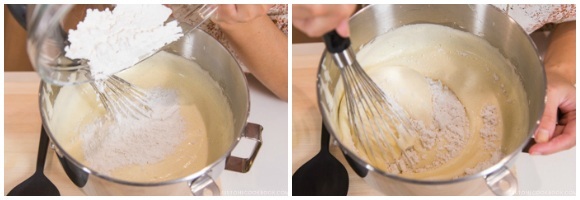
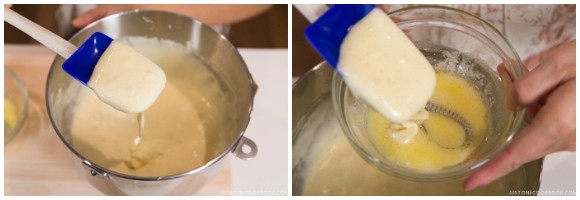

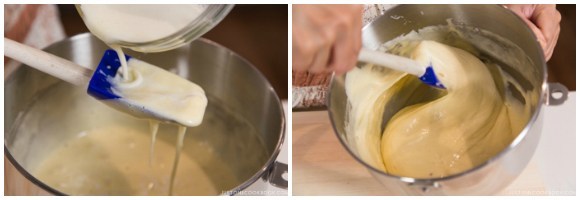

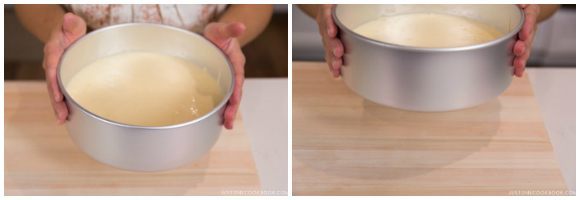
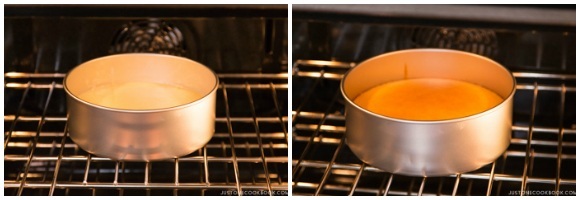
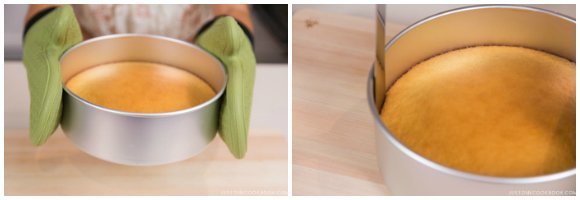
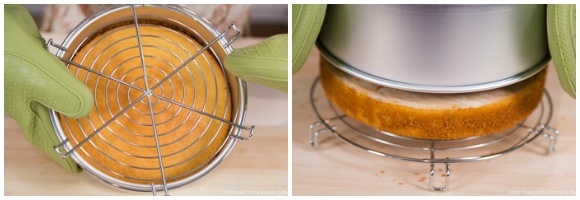
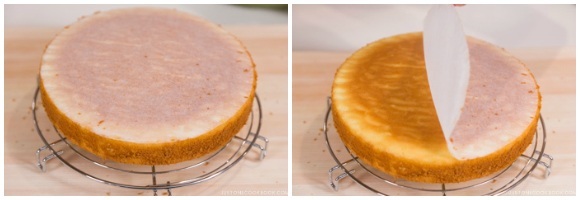
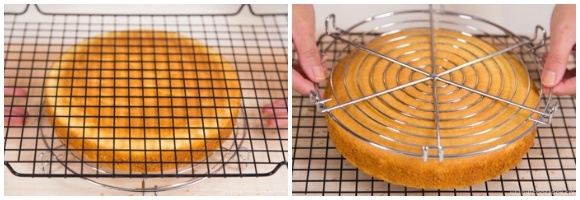
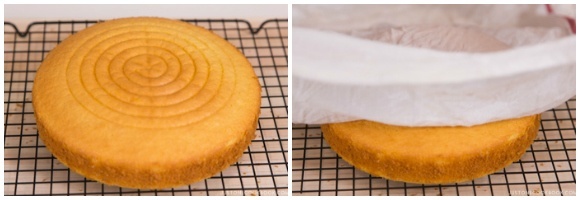
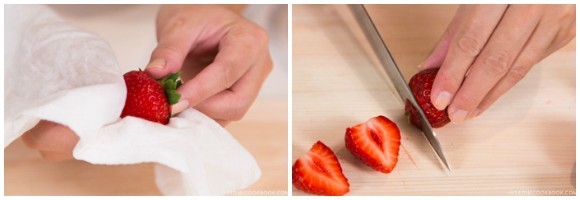
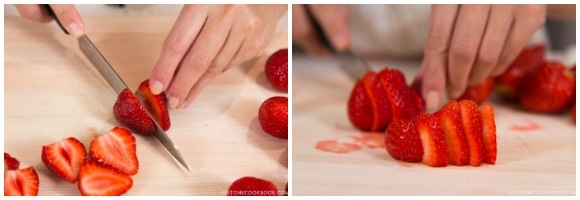
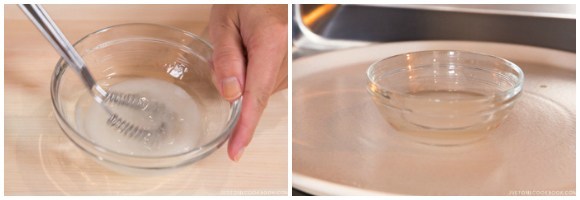
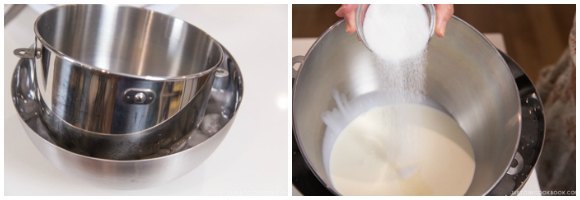
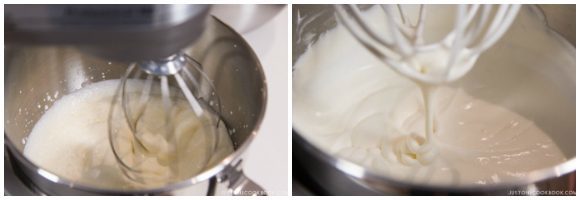
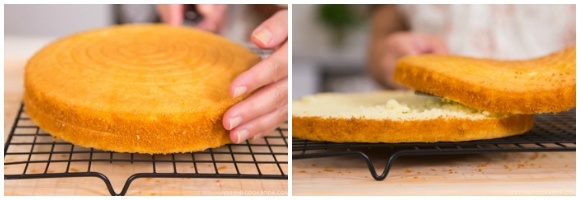
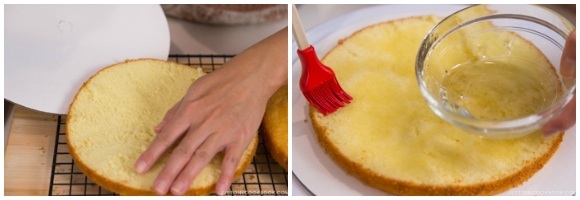
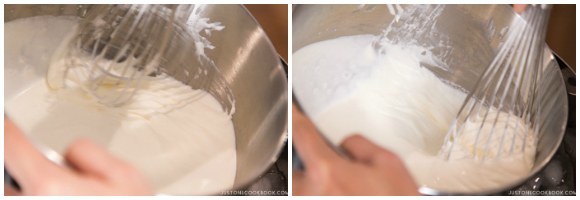
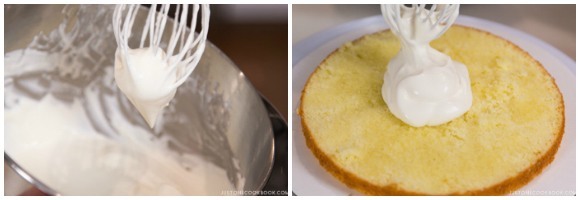

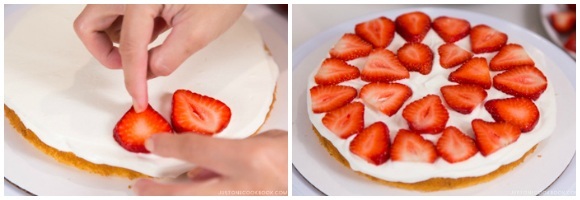

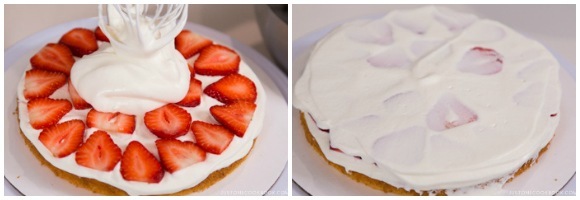
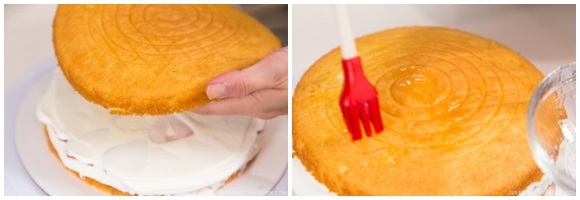
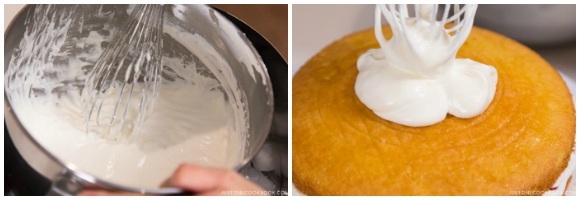
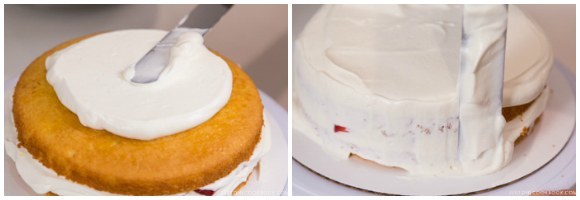
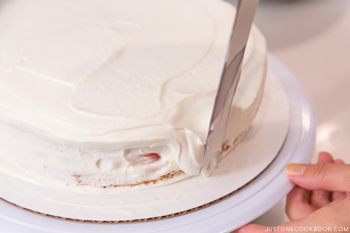
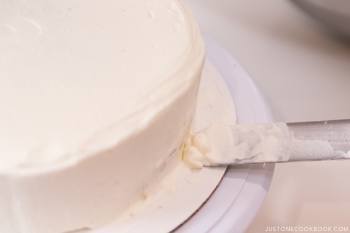

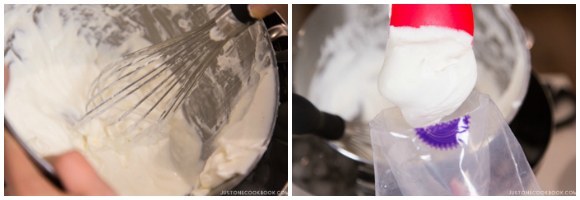

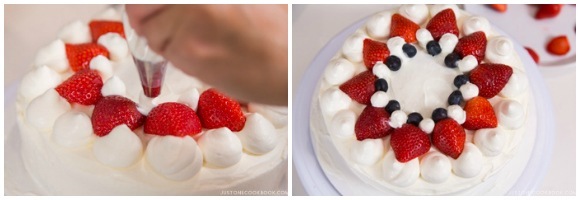
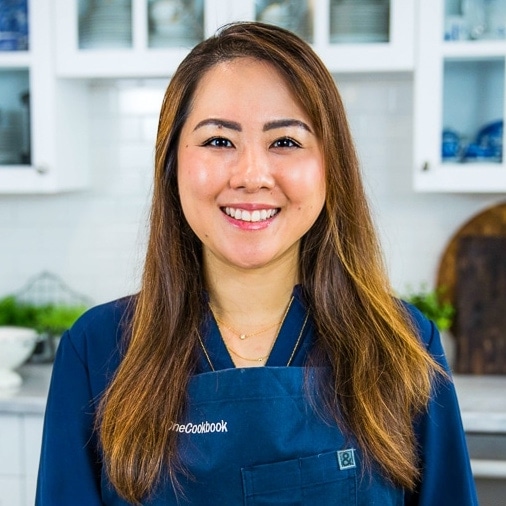
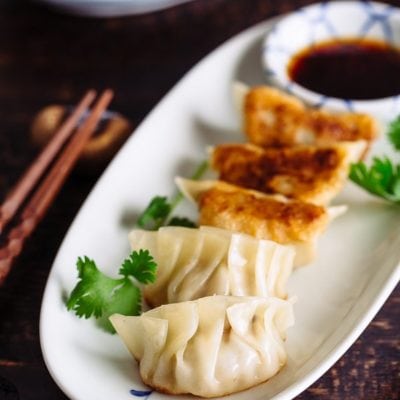
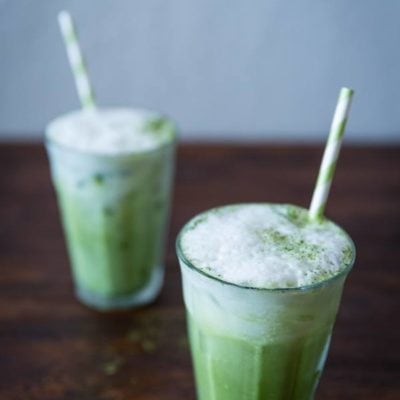
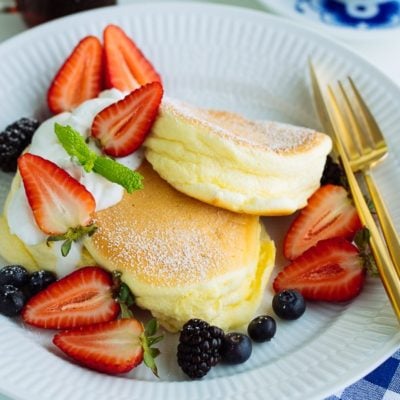
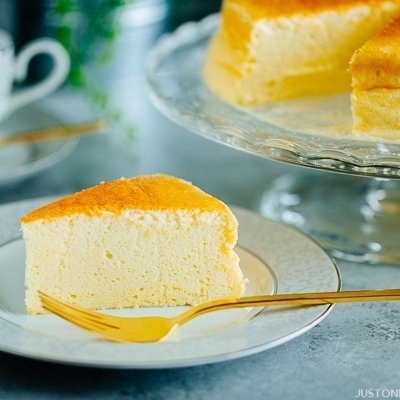
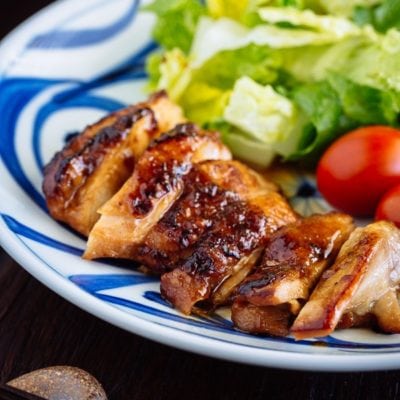

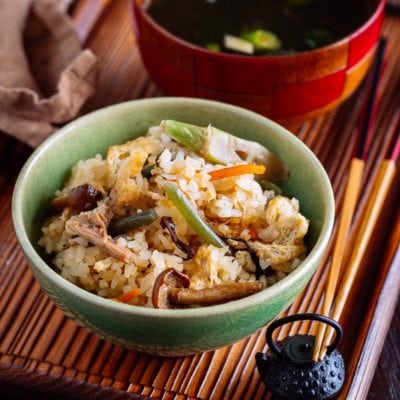
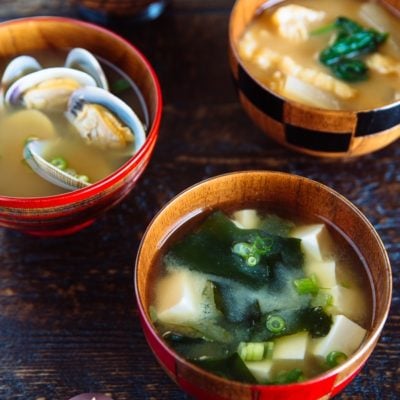


Can you make a video of how to make this please
Hi AJ! Thank you very much for reading Nami’s post and your request! We will add it to Nami’s list.🙂
In the meantime, we hope you enjoy Nami’s detailed instructions!☺️
Can this be made without a stand mixer?
Hi Morgan! Thank you very much for reading Nami’s post and trying her recipe!
Sure, you can make this without a stand mixer.😉
Hello Nami, your recipe is delicious.
Hi Maria! Thank you very much for trying Nami’s recipe and for your kind feedback!
Nami and JOC team are so happy to hear you enjoy the Strawberry Shortcake! Happy Baking!
This looks so delicious! Can I swap out the circle cake pan for a square one?
Hi Maia! Thank you very much for reading Nami’s post!
Sure, you can try a square shape. Please feel free to adjust the baking time as you need.😉
Hi! This is my go to cake recipe and I was wondering if I could possibly make this chocolate flavored? Thanks!
This looks absolutely beautiful! I’m thinking of making this for my grandma’s birthday 🙂 Can I use pasteurised eggs instead of normal eggs and skip the bain marie step? i have some leftover pasteurised eggs from making tiramisu 😀
Hi Nicole, Thank you very much for reading Nami’s post and trying her recipe!
This cake is a genoise cake, made by beating air into the eggs to make the sponge cake rise rather than using a chemical leavening agent like baking soda or baking powder.
The whipped eggs would be more stable if you used the bain marine step. So we recommend using the step even you use pasteurized eggs.🙂 We hope this helps!
Baking this was such a wonderful journey that I don’t think I’ve taken so many photos for each step! Though my frosting is as messy as ever, this is one delicious cake! It tasted even better on the 3rd day and I ate a slice for 3 days in a row! 😂 Love the whipped cream frosting! Thanks for the detailed step by step instructions and photos! Looking forward to try other recipes in this blog! Keep up the good work, Namiko! 👍🏼
Hi Jules! Thank you very much for trying Nami’s recipe and for your kind feedback!
Nami and JOC team are so happy to hear you enjoyed the Japanese Strawberry Shortcake!
We hope you enjoy many recipes from our site. Happy Baking!😊
This is my go to recipe (and my go to recipe site)! I really prefer this kind of airy less sweet cake. I did cut down a little on the sugar, because of the syrup as well. I had some problems with my cake being a little dense, so I actually seperated the eggs and whipped the egg whites and yolks seperately and added another half teaspoon of baking powder and it still works great. I have added lemon juice and lemon zest, dried raspberries and also changed up the syrup and it always comes out delicious. My friends got me the JOC cookbook as well, so I’m excited to try out even more!
Hi Julia! Wonderful! We are so happy to hear you enjoyed Nami’s recipe, and thank you for sharing your baking experience with us!
We hope you continue to enjoy many recipes from our website and JOC cookbook. Happy Cooking!😊
Hi there! May I know if I can use the same recipe in an 7inch cake pan instead? What would the recommended baking time be? Thank you so much. 🙂
Hi Deserie! Thank you very much for trying Nami’s recipe!
Yes, you can bake this in the 7-inch cake pan!
However, the cake will be taller than the original recipe. Try lowering the temperature by 25 degrees, extend the baking time to 23~28 minutes, and test for doneness.
Every oven is different, so we recommend checking the cake early than too late.
We hope this helps!
Hi, i have tried the recipe for the 2nd time. Taste really good but i cant seem to get it right for the sponge cake. My bottom is always hard but the top is nice and fluffy. Any reason why?
Hi Joyce! Thank you very much for trying Nami’s recipe!
The dense and complex texture could be from over mixing and develop the gluten too much. To avoid over mixing, once you add flour, mix gently from the bottom of the bowl.
Also, recommend checking your oven’s internal temperature with a thermometer. Sometimes the internal temperature is not the same as it shows.
We hope this helps!
Can I use two 8” cake pans instead of 1 so that I don’t have to cut it in half? Or is it preferable to cut it in half?
Hi Krys! Thank you very much for trying Nami’s recipe!
Yes. You can bake in the two cake pans. However, please note that the edge of the cake would have a different texture when it is cut.
And please adjust the baking time for the thinner cake batter.😉 We hope this helps!
Hi Nami, thank you for sharing your recipe. My cake has risen wonderfully. However, the top isn’t soft or flat and seems to be very airy, and crumbly (a crunchy, hard like texture) when pressed down on. I was wondering what the cause of thie may be? Thank you!
Hi Teresa! Thank you very much for trying Nami’s recipe!
It sounds like your cake got a little bit overbaked. Each oven works slightly differently, so in your case, please shorten the baking time a little.
We also recommend checking your oven’s internal temperature with a thermometer once in a while so that your oven temperature gauge is showing the correct temperature.
We hope this helps!
Hi Nami, It’s taken me months to write this post but I wanted to let you know I made this special cake for my Mom on Mother’s Day and it sure was hard work but it came together beautifully. We both love クリスマスケーキ but I could never find a good recipe for it. With the amount of work (two simultaneous bain maries!!), it is definitely a special occasion cake. 🙂 Thanks for working so hard with your friend Naomi to create and fine-tune this recipe!! I tried to attach a photo of my cake – not sure it’ll work but if it does, it looks more like a 4th of July cake.
P.S. We follow each other on Peloton but so far my timing has been bad and I haven’t caught you during a work out yet! Maybe one day!
Hi Mai! I’m so happy to hear that you enjoyed making this cake for your mom and it came out beautifully. Thank you for trying my recipe! And I look forward to cycling with you in the near future!
Tried the recipe and omg! It taste very good! Steps are very clear!!
Hi Michelle! We are so happy to hear you enjoyed the Japanese Strawberry Shortcake!
Thank you very much for trying Nami’s recipe and for your kind feedback.🥰
Can I use 2 baking pan instead of 1? As I would like to skip the step on slicing the cake into 2.
Hi Willkam, Sure, you can. However, we haven’t tested the 2 baking pan, and not sure about the baking time. Please feel free to adjust it!
Thank you for trying Nami’s recipe!